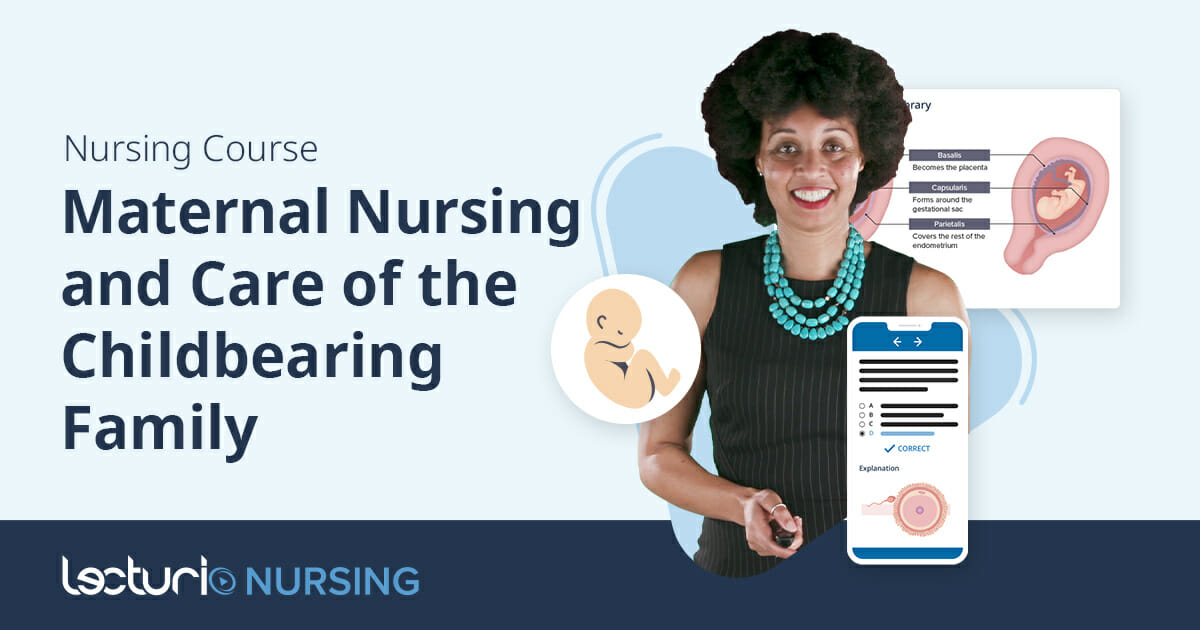As a student who just completed the Maternity & Newborn Nursing course and clinical rotation, I’m eager to share a handful of study tips that helped me along. Plus, I’ll give you a heads-up on what you can likely expect from the accompanying clinical rotation.
What Makes the Maternity & Newborn Nursing Class Hard?
Before we dive in, let’s first talk about what makes the Maternity & Newborn Nursing class so tricky. The main challenge with this class and rotation comes from the unique circumstance of dealing with two patients at once.
As the nurse of a pregnant mother, you not only have to worry about the well-being of the mother but also the well-being of her unborn baby. Once the baby arrives, you’re now caring for the postpartum mom and her newborn, so your patient count doubles!
This two-in-one situation means that you have to know the specialized information on how to care for both a mother in various stages that all require different things and how to care for both a baby in utero and a newborn, who also need different things.
Essentially, there is a lot to know and quite a bit of it is different from the standard nursing information you have been learning thus far in school.
Study Tips for Maternity & Newborn Nursing
So, the big question is: If there is so much to know, what is the best way to study and remember it all? Well, here are some tips I found quite helpful that allowed me to pass on my first attempt.
Master maternity nursing with the all-in-one online course
From understanding the menstrual cycle to pregnancy assessment, initial visits, fetal monitoring, and practice questions: Dr. Jacquelin McMillian-Bohler will guide you to success.
Spot the patterns
My first tip is to notice the patterns. You’ll see patterns in two ways with Maternity and Newborn Nursing:
- In the test questions
- In the presentation or symptoms of pregnancy, labor and delivery, postpartum, and newborn stages
Patterns will typically be something along the lines of: If the question is phrased “X” way, then the answer they are looking for is “Y,” or when you see symptom “A,” this is a red flag and often implies “B”. Let’s give you an example of each of these.
Consider this question: A laboring mother has had ruptured membranes for 24 hours. What should the nurse be on the lookout for? The key detail here is that the membranes have been ruptured for 24 hours, so the nurse will be on the lookout for signs of infection. Over time, you’ll notice that anytime they give you a long duration of ruptured membranes, the correct answer will be the one that addresses the infection risk.
Now, for an example of symptom patterns: These are a bit easier to spot. As you work through the course, you’ll notice things like an orange skin color in a newborn always indicates jaundice, excessively quick labor or excessively long labor always increases the risk for hemorrhage, and the pressure feeling of a bowel movement in a laboring mom always points to imminent delivery.
Taking note of these associations will help you pass your exams and know what is going on in your clinical rotation because you’ll automatically know that when you see “X,” you should be looking for “Y.”
Make use of practice questions
Since noticing the patterns in test questions is a key to success, it’s no surprise that you’ll need to utilize all of the practice questions you can get your hands on. The only way to see patterns is to get as many practice questions under your belt before the exam as possible.
However, with practice questions, it’s not just about doing them all day long. To make the best use of your study time, you’ll want to pay attention to the rationales that accompany the practice questions. Even if you got a question right, if you would not be able to explain the answer to someone that knows nothing about nursing, then you should be reading the rationale and studying it until you can.
The practice question rationales also help uncover patterns because they will be repeating some of the same things over and over.
Utilize additional resources
Though your nursing program probably gives you access to a textbook and accompanying software for practice questions, don’t hesitate to try out additional resources.
There are plenty of free and paid options that can explain things in varied ways that you might understand better, provide mnemonics to help you remember, or simply break it down and connect the dots even further than your textbook. Some of my favorites are YouTube, Lecturio, and Quizlet.
Separate your studying into subsections
My final tip for studying Maternity & Newborn nursing is to divide your studying sessions into subsections.
Remember how I was talking about all of the stages being separate and you having two patients in one for this course? Well, since each of them comes with its unique set of critical information, divide your studying sessions into prepartum, labor, postpartum, and then newborn.
By doing this, you won’t confuse yourself while trying to get the basics down. You’ll create a strong foundation for each type of patient, so then you can isolate the information you will need to pull from when the practice questions inevitably bounce back and forth between scenarios.
The Maternity & Newborn Nursing Clinical Experience
Either during your Maternity & Newborn coursework or after, you’ll be expected to complete a clinical rotation for the subject. For this, you’ll likely be placed in a hospital or birthing center facility and paired with a nurse or clinical instructor to care for patients in the various stages of pregnancy, labor, childbirth, and postpartum. Ideally, you will get hands-on experience with patients in all of these stages.
What to expect
So what should you expect? Well, for my Maternity & Newborn clinical rotations, I had no idea what to expect and I was quite nervous, especially because I don’t yet have children of my own. If you are feeling anxious about your Maternity & Newborn clinical rotations, I’m here to tell you: I promise it isn’t as crazy or intense or as stressful as you might think.
Contrary to your other nursing rotations, where you’ve likely been involved in direct patient care, Maternity & Newborn clinicals typically are more hands-off and you’ll mostly just be expected to observe.
The nurses on these units understand that this is a highly specialized area of nursing that takes a lot of experience and practice to do, so they do not expect you to be able to jump in and take the lead on anything. Helping to bring life into the world is a beautiful aspect of healthcare and a whole other level of joy, but don’t be surprised if you’re not practicing many skills hands-on.
Most of what you should get out of this rotation is simply exposure to the specialty.
A piece of advice
Above all, my best advice for Maternity & Newborn rotations is to remember that you are taking part in a very intimate and personal experience, so be respectful of that. Thank the mothers for allowing you to observe, learn, and be involved. Additionally, don’t focus too hard on getting to do this or that. Just take in everything going on around you and use the opportunity to ask questions (appropriately).
Final Thoughts
Ultimately, though I don’t think Maternity & Newborn Nursing is the hardest class in nursing school, it is much different than the rest of the courses. This is why having some specific study tips and knowing what to expect for clinical rotations is so important. If you focus on the patterns, do all the practice questions you can, and separate your studying into subsections, it just might help you pass this class with flying colors.
And as far as the clinical rotations go? Don’t stress too much and simply take in the experience around you because it really is the most exciting and beautiful rotation in nursing school.





